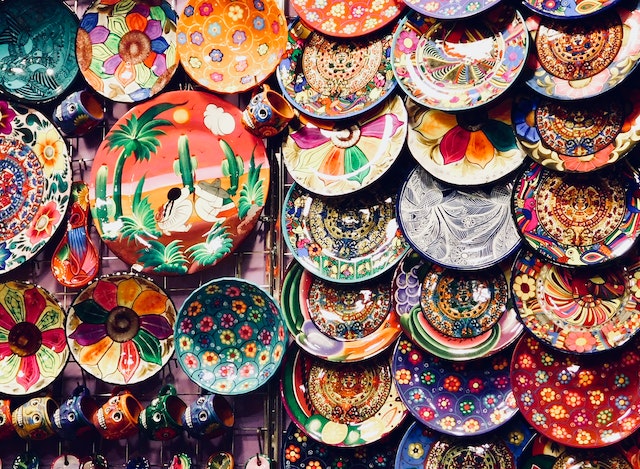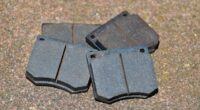Ceramics refer to a broad category of materials that are made from clay and other inorganic compounds. Pottery, specifically refers to objects that are created through the process of molding and firing clay.
TL;DR Ceramics Vs. Pottery
Ceramics is a broad category of clay-based products, including pottery. Pottery specifically refers to vessels and containers made from clay, often for utilitarian purposes.
Ceramics can encompass a wider range of items, such as tiles, figurines, and sculptures, beyond functional pottery.
What is ceramics?

Derived from the Greek word “keramikos,” ceramics refers to any object made from clay that has been hardened through heat. It’s a broad term that encompasses a wide range of creations, from delicate porcelain vases to sturdy terracotta pots.
What is pottery?

Pottery is an ancient art form that has been practiced by human civilizations for thousands of years. It involves creating objects out of clay and then firing them at high temperatures to harden the material. The end result can range from functional vessels like bowls and cups to decorative sculptures and tiles.
Ceramics Vs. Pottery – Key differences
| Aspect | Ceramics | Pottery |
|---|---|---|
| Definition | A broad category of objects made from clay and fired at high temperatures | A subset of ceramics that specifically refers to vessels and containers made from clay |
| Scope | Includes a wide range of clay-based products, such as tiles, figurines, and sculptures | Focuses on functional or decorative clay vessels like bowls, mugs, and vases |
| Purpose | Utilitarian, decorative, and artistic purposes | Primarily utilitarian, but may also serve decorative or artistic functions |
| Firing Technique | Fired at various temperatures, including low, medium, and high temperatures | Generally fired at high temperatures to make it stronger and less porous |
| Composition | Can include a variety of materials, including porcelain and stoneware | Mainly composed of earthenware, stoneware, or porcelain clay |
| Use of Glazes | May or may not be glazed, depending on the desired finish | Often glazed to enhance appearance and functionality |
| Production Method | Can involve both handcrafted and mass-produced techniques | Often handcrafted, reflecting the artisan's skill and creativity |
| Historical Significance | Has been used for thousands of years in various cultures | Historically significant in many civilizations for functional and artistic purposes |
Characteristics of ceramics
Ceramics have the ability to withstand extreme temperatures and resist corrosion. Ceramics can also be adorned with glazes or decorative finishes before firing. These coatings add vibrant colors and unique textures to ceramic pieces.
One of the most captivating aspects of ceramics is its versatility. From functional kitchenware like plates and bowls to decorative sculptures and tiles, there seems to be no limit to what can be created with this versatile material.
Characteristics of pottery
One key aspect of pottery is its handmade nature. Unlike mass-produced ceramics, each piece of pottery is unique, reflecting the individuality and creativity of the artist who made it.
Another important characteristic of pottery is its versatility. Clay can be shaped into various forms using different techniques such as wheel throwing, hand building, or slip casting.
Artists can experiment with different glazes, colors, and textures to achieve their desired aesthetic effects.
Types of Ceramics
Ceramics are a diverse category of materials, and there are several types based on their composition, firing temperature, and properties. Some common types of ceramics include:
- Earthenware: Low-fired ceramics with a porous and rustic appearance, often used for decorative or utilitarian purposes.
- Stoneware: High-fired ceramics that are more durable than earthenware, commonly used for dishes, cookware, and decorative items.
- Porcelain: A type of high-fired and fine-grained ceramic known for its translucency and white color, used for tableware, figurines, and decorative objects.
- Bone China: A type of porcelain that contains bone ash, giving it a delicate and translucent quality, often used for fine dinnerware.
- Terracotta: A type of earthenware fired at a low temperature, known for its reddish-brown color, and often used for flower pots and architectural elements.
- Raku: A Japanese ceramic technique that involves rapid firing and quick cooling, resulting in unique and unpredictable glaze patterns.
- Refractory Ceramics: Highly heat-resistant ceramics used in kiln linings, furnace components, and other high-temperature applications.
- Ceramic Fiber: Insulating material made from fine fibers used in various high-temperature applications, such as thermal insulation.
- Advanced Ceramics: Technologically advanced ceramics with exceptional mechanical, electrical, or thermal properties, used in cutting-edge industries like aerospace and electronics.
Types of Pottery
Pottery encompasses a wide range of vessels and containers made from clay. There are various types of pottery based on their uses, techniques, and cultural origins.
- Earthenware Pottery: Low-fired and porous pottery, often used for everyday tableware and decorative items.
- Stoneware Pottery: High-fired and more durable than earthenware, suitable for functional dinnerware and cooking vessels.
- Porcelain Pottery: Fine and translucent pottery, known for its elegant appearance, used for delicate tableware and decorative objects.
- Majolica Pottery: Earthenware pottery with a tin glaze, typically decorated with colorful painted designs, popular in Mediterranean and Mexican cultures.
- Raku Pottery: A Japanese pottery technique involving rapid firing and cooling, creating unique and often unpredictable glaze patterns.
- Terracotta Pottery: Low-fired reddish-brown pottery, commonly used for flower pots, tiles, and sculptures.
- Slipware Pottery: Pottery decorated by applying liquid clay (slip) with various techniques, creating patterns and designs.
- Mingei Pottery: Traditional Japanese folk pottery, characterized by simplicity, functionality, and connection to nature.
- Anasazi Pottery: Ancient Native American pottery produced by the Anasazi people, known for its distinctive designs and intricate craftsmanship.
- Greek Black-Figure and Red-Figure Pottery: Ancient Greek pottery styles with black and red painted designs, depicting scenes from mythology and daily life.
How can you tell pottery from ceramic?
Pottery
- Function: Pottery typically refers to vessels and containers made from clay that are designed for utilitarian purposes, such as bowls, plates, cups, and vases.
- Firing Temperature: Pottery is often low to medium fired, resulting in a more porous and rustic appearance compared to high-fired ceramics.
- Surface Finish: Pottery may have a rougher texture and may not be as smooth and refined as high-fired ceramics.
- Typical Types: Types of pottery include earthenware, stoneware, terracotta, and majolica, among others.
Ceramics
- Broad Category: Ceramics is a more encompassing term that includes various clay-based products, not limited to just vessels. It includes items like tiles, figurines, sculptures, and advanced technical ceramics.
- Firing Temperature: Ceramics can be low, medium, or high fired, depending on the specific type and its intended purpose.
- Surface Finish: High-fired ceramics, like porcelain, are known for their smooth, fine-grained appearance and can have a translucent quality.
- Typical Types: Types of ceramics include earthenware, stoneware, porcelain, bone china, raku, refractory ceramics, ceramic fibers, and advanced ceramics.
Pottery typically refers to functional vessels made from clay and is often low to medium fired, while ceramics is a broader category that includes a wider range of clay-based products, some of which can be high fired with refined finishes.
Image Credits
Featured Image By – Photo by Sanketh Rao on Pexles
Image 1 By – Luisella Planeta LOVE PEACE from Pixabay
Image 2 By – Lubos Houska from Pixabay








